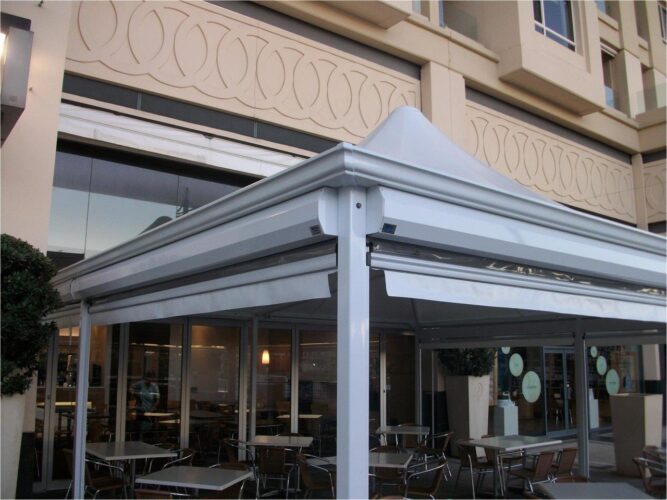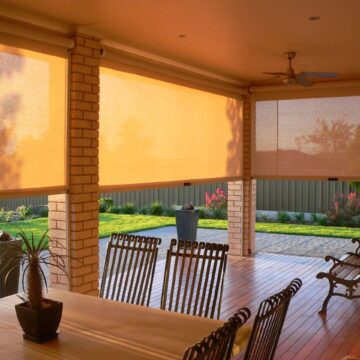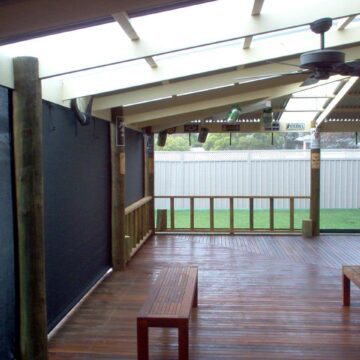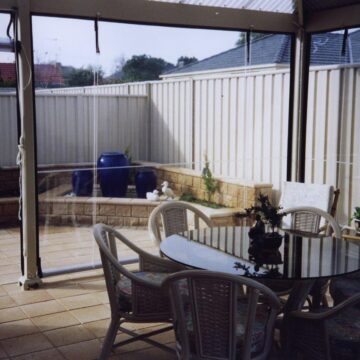Ziptrack outdoor blinds—sold under the Ziptrak® name—are Australian-made screens that slide inside slim aluminium side-channels, sealing the edges to keep wind, rain and insects out while the view stays in. With effortless spring-balanced or motorised control and uncluttered looks, 2025 pricing runs from about $1200 to $2,500+ per blind for most South Australian homes, dictated by width, fabric and automation.
That mix of weather control, smooth operation and clean lines has made track-guided blinds the upgrade of choice for Adelaide patios, verandas and café frontages. Instead of packing the barbecue away when the first southerly hits, homeowners just lower the blind to create an instant, sheltered room that still feels open to the garden. Café owners like how it stops tables rattling in the wind while keeping diners comfortable year-round. The sections ahead unpack features, costs, fabrics and installation paths so you can judge whether they’re right for your space.
What Are ZipTrack Outdoor Blinds and How Do They Work?
Ziptrack outdoor blinds are the original patented, track-guided exterior screens made in Australia under the Ziptrak® banner. Rather than flapping on ropes or needing a wobbly crank, each blind glides inside slim aluminium side-channels. A hidden spring (or a discreet motor) counter-balances the fabric, so you can stop the blind at any height with one hand and click it into place at the bottom. The sealed edges block draughts, mozzies and drizzle without boxing in the view, turning open patios, café footpaths and office balconies into usable rooms in seconds.
Track-Guided Design Explained
The secret sauce is the continuous spline that’s heat-welded to both vertical edges of the fabric. This spline slides snugly inside extruded aluminium tracks, creating a gap-free seal—≈ 0 mm between fabric and post. Because the fabric can’t whip sideways, there’s no rattling in gusty Adelaide southerlies and far less wear over time. Compare that with cord-guided or crank awnings where the cloth is only tensioned at the corners; gusts push the centre inwards, letting wind, dust and insects sneak through.
Components and Terminology
- Top tube / roller – the aluminium barrel the fabric winds around.
- Pelmets / hoods – optional covers that hide and protect the roller.
- Side tracks – powder-coated aluminium channels fixed to posts or walls.
- Spline – flexible PVC strip welded to fabric edges; engages in tracks.
- Bottom bar – weighted aluminium bar you grip to lift or lower; contains the latch.
- Operation – spring-balanced manual as standard; 240 V or lithium motor as upgrade.
- Centre-lock release – lets you lock or unlock from inside or outside with a gentle lift.
Learning the lingo helps when comparing quotes—if a supplier skimps on items like pelmets or anodised tracks, the price difference suddenly makes sense.
Suitable Applications Around the Home or Business
You’ll spot these blinds enclosing pergolas for winter dinners, shielding west-facing verandas from low afternoon sun, or lining café frontages along Henley Beach Road. Childcare centres use the clear PVC version as a windbreak that still allows staff to supervise outdoor play, while apartment managers install mesh blinds on balconies to meet strata privacy rules without sacrificing airflow. In most South Australian councils, they’re classed as “shade structures,” so approval is rarely needed unless the blind sits on a boundary—always check if you’re in a heritage zone.
Key Features and Benefits You’ll Notice Straight Away
Upgrade an alfresco with any shade sail and you’ll feel the difference; fit ziptrack outdoor blinds and you’ll wonder why you waited so long. The patented track-guided design bundles weather control, user-friendly handling, energy savings and architectural polish into one neat package. Below are the four things customers tell us they notice the very first weekend after installation.
Weather Protection: Wind, Rain, Sun & Insects
Ziptrack outdoor blinds grip the side channels firmly, so wind can’t bell the fabric or let rain creep round the edges. In independent tests the standard system handles gusts around 100 km/h, while the HD version is rated higher for coastal or hill-face sites. Clear PVC blocks wind completely; high-tech mesh cuts up to 95 % of damaging UV without turning the area into a sauna. Are they waterproof? Close enough for most barbecues—water will bead and run off—but no exterior blind can promise a perfect seal, so keep flooring graded and add gutters where splash-back is a concern. Mozzies, midges and December march-flies also stay outside, meaning dinner on the deck can go the full five courses.
Smooth Operation & Stop-Anywhere Convenience
Forget dangling cords or slow crank handles. A calibrated spring inside the top tube counterbalances the fabric so the blind glides with fingertip force and can stop at any height: halfway for a cross-breeze, three-quarters when the sun’s on the horizon, fully down when the forecast turns ugly. The centre-lock release clicks into the bottom track for security, yet unlocks with a gentle lift. Prefer push-button luxury? Add a 240 V or solar-powered motor and control several blinds at once.
Energy Efficiency and Year-Round Comfort
By blocking direct solar gain before it hits the glass, mesh track blinds can cut radiant heat transfer by up to 50 %. In winter the trapped air layer behaves like a mini-insulation blanket, slashing wind chill and helping outdoor heaters work less hard. The result: alfresco areas usable another three months each year and measurable savings on indoor cooling bills.
Aesthetic Integration With Aussie Architecture
Because the fabric runs inside slim aluminium tracks, there are no flapping edges or bulky tie-downs—just a clean, vertical plane that disappears into its pelmet when retracted. Tracks and hoods can be powder-coated to match Colorbond® gutters or timber stains, while fabrics come in dozens of neutral and statement hues. The effect is a blind that looks designed for the house, not bolted on afterwards, preserving street appeal and adding resale value.
How Much Do Zip Track Outdoor Blinds Cost in Australia in 2025?
Nobody likes a mystery price tag. The good news is that zip track outdoor blinds follow fairly predictable pricing once you know the dimensions, fabric and operation type. For most metropolitan Adelaide homes you’re looking at roughly $1200 on the low end for a small manual mesh screen up to $3,500 plus for a four-metre-wide, motorised clear PVC unit. Commercial-grade HD systems or unusually tall spans can nudge higher, but the majority of residential projects sit comfortably inside that band.
Cost Factors: Fabric Choice, Motorisation, Site Complexity
Several moving parts decide the final figure:
- Fabric: Clear PVC runs 15–25 % dearer than mesh due to thickness and welding labour.
- Power: Plug-in or hard-wired motors add
$500–$700per blind; solar-powered lithium tops that by another$100. - Mounting surface: Brickwork requires anchors and extra labour, while steel RHS posts are simpler. Uneven paving may need aluminium packers or a custom bottom skirt.
- Access & height: Second-storey balconies often need scaffolding or boom hire—budget
$600+. - Regional freight: Outside greater Adelaide, allow
$50–$150per unit for transport.
Budgeting Tips and Ways to Save
- Order multiple blinds together—the installer’s call-out and travel time are shared.
- Stick to the standard Colorbond® powder-coat palette; custom Dulux hues add up.
- Schedule installs in winter when factories are quieter; many suppliers run off-season promos.
- If you’re handy, a DIY kit can shave 20 % off labour, but weigh that against the warranty benefits of professional fit-out.
Long-Term Value: Resale, Energy Savings, Lifestyle
A patio enclosed with track-guided blinds is useable for an extra three months a year. One Adelaide family with three 3 m mesh blinds saw indoor cooling costs drop by about $150 over the first summer (smart meter data). Real-estate agents report that a weather-proof alfresco can lift buyer appeal, translating to thousands in perceived value. Factor in less sun-bleached furniture and fewer café-bill weekends away from home, and the upfront spend starts looking more like an investment than an indulgence.
Choosing Fabrics, Colours, and Optional Upgrades
Picking the right fabric and finish is the part where ziptrack outdoor blinds move from a generic product to something that feels tailor-made for your patio or frontage. A clear PVC screen on a seaside deck behaves very differently to a charcoal mesh on a north-facing café, and the extras you bolt on—motors, sensors, pelmets—can make day-to-day living either effortless or fiddly. Use the mini guide below to narrow the field before you meet the rep with the sample book.
Colour Palette Considerations: Matching Roofing, Frames & Décor
The aluminium tracks and pelmets come powder-coated in the Colorbond® plus dozens of Dulux custom colours. As a rule of thumb:
- Match tracks to existing window frames if you want the blind to visually disappear.
- Go one shade darker than rendered walls for a slimline shadow-line effect.
- Light fabrics reflect heat but show dirt; darker tones blend with landscaping and reduce glare.
Bring a roof tile or gutter sample when you order—it avoids guesswork under showroom lighting.
Smart Upgrades: Motorisation, Sun & Wind Sensors, Pelmets
- Motors: Hard-wired 240 V units add push-button ease and integrate with home automation hubs; lithium solar kits suit areas with no nearby power.
- Sensors: A combined sun/wind sensor can automatically raise blinds in high gusts or drop them when afternoon rays hit, prolonging fabric life.
- Pelmets and hoods: Enclose the top roll to keep spiders, dust and coastal salt spray at bay. Flush-box pelmets disappear under eaves; retrofit hoods screw onto existing brackets.
Compliance With Bushfire, Coastal and Pool Regulations
South Australian bushfire zones may require mesh that meets BAL-29 or higher; check the product’s fire-retardant rating on the spec sheet. In coastal suburbs, opt for marine-grade powder-coat and stainless fixings to prevent corrosion. Around regulated pools, blinds must not intrude into the 900 mm clear zone when retracted—choose a recessed pelmet or mount tracks outside the fence line to stay on the right side of the inspector.
Installation Path: DIY vs Professional Fit-Out
Choosing between rolling up your sleeves or handing the job to a qualified installer comes down to three things: confidence with the tape measure, access to the right tools, and how much free time you’re willing to burn. Zip track outdoor blinds aren’t rocket science, but a millimetre error or crooked track can turn that smooth glide into an annoying scrape. The cheat-sheet below shows what’s involved on both sides of the ledger so you can decide which route suits your patio—and your nerves.
What to Expect From Professional Installation
A licensed installer will return for a check-measure, confirm fixing points, and flag any substrate quirks before the blind goes into production. On fitting day the crew arrives with drop sheets, trims tracks on site if walls aren’t true, and tension-balances the springs so the blind holds at any height. Hard-wired motors require a sparky—insurance insists.
Typical Installation Timeline and After-Sales Support
Metro Adelaide lead time runs three to four weeks from deposit in winter, up to six in the pre-Christmas rush. Actual fitting is quick—about 90 minutes per blind plus cabling. Most pros include a 12-month workmanship warranty and one free adjustment visit, handy if new house frames settle or you just fancy the glide a tad lighter.
ZipTrack vs Competing Track-Guided Systems
Not every track-guided blind on the market wears a Ziptrak® badge. Competitors such as ZipScreen™ and eZIP® offer similar concepts but differ in hardware, span limits and price. The quick comparisons below will help you decide whether the original is worth the extra dollars or if another system ticks your boxes.
ZipTrack vs ZipScreen
| Feature | ZipTrack | ZipScreen |
|---|---|---|
| Edge sealing | Welded spline in aluminium track | Zipper inside aluminium track |
| Operation | Spring-balanced manual or motor | Crank or motor (no spring) |
| Max span (standard) | 6 m manual, 7 m motor | 5 m motor only |
| Wind rating | ~100 km/h (HD higher) | ~80 km/h |
| Speed to deploy | Seconds (one-hand lift) | Slower crank turns |
| Price per m² | Slightly higher | Moderate |
In practice, homeowners pick Zip Track for its effortless stop-anywhere glide and better wind resistance; venue managers sometimes lean to ZipScreen when a motorised, zipper-edge blind meets specs and shaves a few hundred dollars off large runs.
ZipTrack vs eZIP and Other Alternatives
eZIP borrows the spline idea but bulks it up with a high-density aluminium frame and internal tension system. It shines on extra-wide spans (up to 9 m) and in cyclonic regions, yet the beefier profile is more noticeable and costs 10–15 % above ZipTrack. Budget DIY brands from big-box stores undercut everyone but usually cap out at 3 m and lack spare-parts support.
Which System Suits Which Situation?
- Alfresco at a windy Adelaide Hills home ➔ ZipTrack HD for top wind rating.
- Ground-floor café with 20 identical bays ➔ ZipScreen motorised keeps costs predictable.
- Coastal yacht club needing 8 m openings ➔ eZIP for the structural muscle.
- Rental patio on a shoestring ➔ Off-the-shelf DIY track blind (expect compromises).
Match your span, exposure and usability priorities first, then let price break the tie.
Caring for and Repairing Your Zip Track Outdoor Blinds
Track-guided blinds don’t ask for much, yet a few minutes’ TLC each month keeps them gliding like new and avoids warranty hiccups. The tips below cover day-to-day cleaning, DIY fixes and the point where a qualified tech is worth the call-out.
Routine Cleaning and Fabric Maintenance
- Mesh: Hose gently every 2–3 weeks, brush with a soft broom and let it air-dry fully before rolling up.
- Clear PVC: Rinse with clean water, wipe with a microfibre cloth and diluted dish-soap; avoid methylated spirits or window cleaner that can cloud the surface.
- Tracks & bottom bar: Blow out leaves, then spray silicone-free dry lube along the channel; oil-based sprays attract grit.
- Sunscreen and insect repellent stain PVC—rinse spills straight away.
Troubleshooting Common Issues (Jamming, Rattling, Tension)
| Symptom | Likely Cause | Quick Fix |
|---|---|---|
| Blind won’t stay up | Spring lost tension | Wind fully up, then down twice to reset balance |
| Fabric drags in track | Debris or warped spline | Vacuum track, inspect edge; replace spline if frayed |
| Rattle in wind | Bottom bar not latched | Engage centre-lock; if latch loose, tighten screw |
| Uneven roll | Out-of-square posts | Shim brackets or refit using packers |
When to Call a Professional for Repairs or Upgrades
- Visible tears wider than a 20-cent coin.
- Bottom bar or side track bent after storm impact.
- Motor hesitates, stalls or trips safety cut-out.
- Springs have no tension even after reset.
Pro techs carry replacement splines, motors and HD tracks that aren’t retail items, and their labour is covered under workmanship warranty.
Warranty Terms and What They Really Cover
Most reputable Adelaide suppliers include:
- 5 years on tracks, springs, pelmets and mesh fabrics.
- 2 years on PVC fabric and tubular motors.
Storm damage, improper cleaning agents and DIY alterations usually void coverage. Keep invoices and the installer’s signed hand-over sheet—both are needed for a hassle-free claim.
Ready to Transform Your Outdoor Space?
Track-guided blinds turn a windswept patio or café strip into a calm, climate-controlled room in seconds. They shut out rain, mozzies and harsh sun without blocking the view, trim energy bills, and add polish that nudges resale value. Expect to spend somewhere between $1000 and $2,500 per opening in 2025, with size, fabric and motorisation doing most of the price heavy lifting.
Getting the measurements bang-on and using a licensed installer protect both performance and warranty, while a simple hose-and-wipe routine keeps the glide silky for years. If you’re ready to make every season entertaining season, our Adelaide team can size up your space, talk fabrics, and pin down a firm figure—no pressure, no guesswork.
Tap below for a free in-home quote and friendly advice from the locals who build and fit them every day:
Classic Roller Shutters Adelaide




